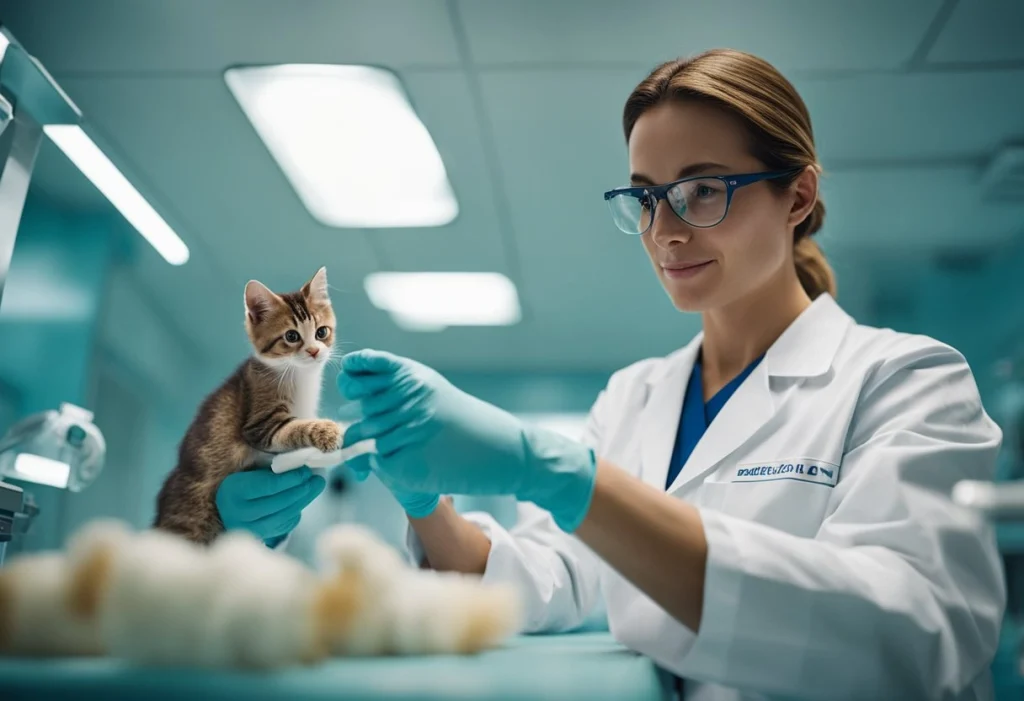Best Age to Declaw a Cat: Understanding Timing and Health Considerations
By: Elizabeth Rikas

The information in this article is intended to educate cat parents and is not a substitute for veterinary guidance. In case of any concerns about your cat’s health, please talk with your veterinarian.
Many cat owners face the decision of whether to declaw their pets. The best age to declaw a cat is between four and six months. At this age, kittens tend to adjust better to the procedure and recover more quickly than older cats.
Declawing is often more successful when performed on younger cats, as their bodies can heal faster. It is important for owners to weigh this decision carefully and consider alternatives that can help manage scratching behavior without surgery.
Owning a cat comes with responsibilities, and ensuring their well-being is a top priority. Understanding the implications and potential risks of declawing can lead to better choices for a pet’s health.
Key Takeaways:
- Kittens are best declawed between four and six months of age.
- Alternatives to declawing are available and can effectively manage scratching.
- Post-procedure care is essential for a cat’s recovery and comfort.
Click to explore about: Salmon Broth For Cats
Understanding Declawing
Cat declawing is a surgical procedure that removes the claws from a cat’s paws. This practice is often controversial and involves general anesthesia. It’s crucial for pet owners to understand the specifics of the procedure and the potential medical conditions and complications that can arise.
The Declawing Procedure
Declawing involves the surgical removal of the last bone in each toe. This is different from simply trimming nails. The surgery is typically performed under general anesthesia to ensure the cat feels no pain during the process.
The procedure commonly takes around 30 to 60 minutes. Post-operative care is essential for healing. Owners should closely monitor their cat for signs of discomfort, bleeding, or swelling.
Veterinarians recommend declawing kittens between the ages of 3 and 6 months, as their recovery is typically quicker. Older cats may take longer to heal and face a higher risk of complications.
Medical Conditions and Complications
While many cats recover well from declawing, there are possible medical conditions and complications to consider.
Some cats may develop behavioral issues after the procedure, such as increased aggression or litter box problems. Pain in the paws can persist long after surgery, affecting their quality of life.
Infection is another significant risk. Wounds need to be kept clean and monitored. Additionally, difficulties in balance and movement can arise, particularly in older cats.
Pet owners should weigh the benefits and risks before making decisions about declawing their cats.
Click to explore: How To Make Cats’ Fur Softer
Age Considerations for Declawing
The age at which a cat can be declawed plays a crucial role in their health and behavior. Different age groups may have varying recovery times and risks associated with the procedure. Understanding these factors is essential for any pet owner considering declawing.
Kittens and Declawing
Kittens can be declawed as early as three months old, typically when they weigh at least three pounds. The procedure is most commonly performed on kittens between 8 to 16 weeks. Declawing at a younger age may lead to a quicker recovery and less pronounced behavioral issues compared to older cats.
When performed early, kittens tend to accept the procedure better. Their ability to heal swiftly is beneficial. Owners may notice less anxiety and a smoother adjustment to their new paws. Early declawing also helps prevent potential scratching issues as the cat grows.
However, it is important to ensure that the kitten is healthy before proceeding with the surgery. Regular vet check-ups can help determine the best time for declawing.
Adult Cats and Associated Risks
Declawing adult cats comes with increased risks. As cats age, their recovery time often lengthens. An adult cat may take two to three weeks to heal completely compared to a kitten’s one week.
Additionally, adult cats may experience more significant behavioral changes post-surgery. They might become more aggressive or develop stress-related issues due to pain or discomfort. Adult cats also have a higher chance of facing complications like infection or chronic pain.
For these reasons, many vets recommend exploring other options, such as training or regular nail trimming. These alternatives can help manage scratching behavior while keeping the cat’s health and well-being intact. The decision should always be made in consultation with a veterinarian.
Alternatives to Declawing
Exploring effective alternatives to declawing can help keep cats safe while addressing behavioral issues. From training and preventive measures to safe non-surgical options, there are several strategies that can support both cats and their owners.
Preventive Measures and Behavioral Training
Preventive measures can significantly reduce the need for declawing. Regular nail trims are essential. Keeping nails short minimizes damage to furniture and reduces scratching accidents. Owners should aim for trims every few weeks.
Behavioral training is also key. Introducing catnip-infused scratching posts encourages positive scratching. Cats often enjoy scratching surfaces that feel good. Additionally, using pheromone sprays may help calm anxious cats involved in behavioral issues, making them less likely to scratch inappropriately.
Incentives can work wonders. Reinforcing good behavior with treats can encourage a cat to use its designated scratching areas instead of furniture.
Click to learn about: Split Claws In Cats
Post-Procedure Care and Considerations
Proper care after declawing is vital for a cat’s recovery and long-term health. Managing the recovery process and being aware of potential infections and behavioral changes can help ensure a successful transition.
Managing Recovery and Infections
After the surgery, the cat typically requires protective care for about one to two weeks. Healing should be monitored closely during this time.
It’s essential to keep the cat’s paws clean and dry. A vet may prescribe pain medications to help manage discomfort. Owners should follow dosages carefully.
Signs of infection include swelling, redness, or discharge from the paw. If these symptoms appear, contacting a veterinarian promptly is crucial. Regular check-ups can help identify any issues early.
Click to learn: Why is my cat breathing rapidly?
Long-Term Health and Behavior
Declawing can lead to behavioral changes in some cats. It is common for them to experience stress or anxiety about their new paw condition. They may avoid using their litter box if the texture irritates their paws.
Providing soft litter and a comfortable environment can help mitigate this. It’s wise to monitor any changes in behavior such as aggression or excessive grooming, as these can be signs of distress.
Owners should also keep an eye on the cat’s mobility. Cats may become less active if they associate pain with walking. Encouraging gentle play can help maintain their physical health and emotional well-being.
Click to know: Do cats like to be petted?
Frequently Asked Questions
Many cat owners have questions about declawing their pets. They often seek information on alternatives, the procedure itself, and important considerations for their cat’s age and well-being. Here are some common inquiries.
Conclusion
Deciding the best age to declaw a cat requires careful consideration of both timing and health implications. Kittens between four and six months typically recover faster and adapt better to the procedure, making this the optimal window. However, declawing remains a controversial practice, and pet owners should explore alternatives like scratching posts, nail caps, or behavioral training to address scratching issues without surgery.
Ultimately, the well-being of the cat should be the top priority. Understanding the risks, recovery process, and long-term effects of declawing is essential for making an informed decision. Consulting a trusted veterinarian and considering non-invasive options can help ensure a happy, healthy life for your feline companion.

About the Author
Elizabeth Rikas
Elizabeth is a passionate advocate for feline health and well-being, drawing from her years as a dedicated pet parent to three cats—Gypsy, Swan, and Alfred—and her invaluable experience volunteering at animal shelters. A seasoned writer with a lifelong love for cats, Elizabeth began sharing her insights in her teens and has since contributed extensively to platforms focused on feline care. Through her expertise and heartfelt dedication, she empowers pet owners with practical advice and research-backed knowledge to nurture their furry companions.
